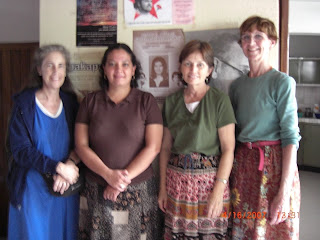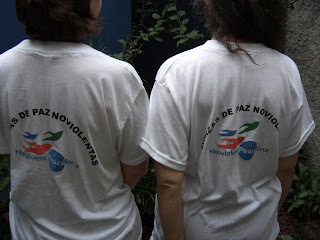The press release from the National Council of Communities for the Development of Guatemala (CONCODIG) stated:
"On Monday 7 May, a group of seven persons were obliged to flee from the community of Los Cimientos of the town of San Bartolomé Jocotenango, in the province of Santa Cruz del Quiche for death threats against those who don't want to be part of the civil defense patrullas which still exists in this town."
"On the 10th of May, another 154 persons also fled for the same reason. Another group of thirty persons came to live in the city of Guatemala in the Colonia of Milagro where they live in subhuman conditions…" (Others have fled to other locations, and currently there are some of them staying in the Academy for Mayan Languages in the city of Guatemala.)
"These men [referring to the Patrullas de Auto-Defensa Civil – members of the militia] have caused deaths to many members of the community since the 80's and again in 2007. The instigators of these threats and crimes are the chiefs of the patrullas. (They name the specific men, all are local Indians). These men have high power assault weapons which they have used to threaten people in the community of Los Cimientos, they have sexually abused (the word in Spanish could also mean raped) the women including both children and adults and have assassinated members of the community as you can see in the complaints to the Ministerio Publico." [which deals with law enforcement]
"We ask that the Government of Guatemala capture these people and punish them in accordance with the law. We ask for the help and immediate protection by the Government for these persons. Also we ask that the Human Rights organizations and the churches condemn these acts of violence, and give their solidarity to these families suffering from the terror that has not ended in this country."
NP field team members met today with the 92 persons living in a house in Zone 1. Angélica Macario, a Quiche woman whose father was assassinated in the 1990s, assisted us with translation (many of the women do not speak Spanish). We were able to determine that:
--They must move out of this house within ten days;
--One woman is pregnant and has no plans for where or how she will give birth;
--Because they fled in May, they were not able to plant their crops, hence will have no harvest in December. They face an economic crisis. They are entirely dependent now on donations from organizations in Guatemala for their subsistence, but even with immediate action on the part of the authorities, they will need assistance at a minimum until January 2009. Even with successful resolution, they will not be able to plant until May 2008 at the earliest.
--Children from babies to teenagers are confined to this house 24 hours a day with only minimal schooling and recreation.
The Los Ciminentos case was brought to La Unidad de Proteccion de Defensoras y Defensores de Derechos Humanos, the group we accompany. The refugee's situation falls outside La Unidad mission of representing human rights defenders. Cases have been filed with the prosecutor and the Guatemalan Human Rights Ombudsman. Police attempted to challenge the patrulleras, but were fired upon. The police fled the community and have not returned. The refugees want very much to return home, but even those who remain there, go to the mountains for safety at night.
According to Liam Mahony and Luis Enrique Eguren Unarmed Bodyguards (Kumarian Press, 1997) "The civil patrols, started in 1981 under the presidency of Lucas Garcia, were a fundamental counterinsurgency tool for keeping the population from supporting the guerrillas [the armed revolutionaries]. Patrol service consisted of a twelve-to twenty-four hour shift without pay each week. Poor campesinos were forced to do road construction, spy on neighbors, and accompany army soldiers searching for guerrillas. A force of 25,000 civil patrollers in 1982 grew to 900,000 by 1984 – more than three-quarters of the adult male population of the northwest highlands." (page 58). During this time, Lucas Garcia and his successor Rios Montt, conducted "scorched earth" genocide against the campesino population with the rationale that campesinos (whose land had been seized legally and illegally over the last hundred years) would side with the guerrillas and must be eliminated.
The army under Lucas Garcia manipulated the more traditional Indian population to turn against their neighbors and relatives because they were involved in Acción Católica which was trying to help the Indian people with fertilizer and buying at cost in cooperatives. Acción Católica and its members were labeled "communist" and thus became the targets of the army. Members of patrullas in Los Cimientos not only participated in the burning of homes and devastation of fields and whole slaughter of the villagers, but they systematically denied women the right to walk in the streets, to have meetings, or to participate in community events. The reason was that they were being raped and kept as sex slaves and the patrulleras didn't want them to name names or even talk to each other. In the oral histories (AVANSCO, Se Cambió El Tiempo: Conflicto y Poder en Territorio K'iche' 1980-1996, 2001) women (some of whom were pre teen girls at the time) interviewed for that study could hardly talk about these "violations" by neighbors and friends. Patrulla members were shot if they refused to rape a woman. Some of the leaders of the patrullas became wealthy through the seizure of people's land and have seized the leadership of the community although the only elected officials are in the town, not in this rural community. Legally, the patrulleras do not exist because involuntary servitude was outlawed by the 1985 constitution. However, the same people still have this de facto power. The deep resentment and helplessness toward the ladinos [non-Indians] from the seizure of Indian land in the 1880s to the 1950s was compounded by the divisions between the Indian campesinos over land reform in the mid 1950s. In the brief period of land reform in the mid 50s, the government seized land from the ladino owners for agricultural reform. The former occupants of the finca (plantation) claimed their right to the land to work communally as had their ancestors. The government also awarded the land to Indian campesinos (farmers) to own individually. So for several years the two groups fought in court over their entitlements to that specific piece of land to no one's satisfaction. It was impossible to have both communal and individual ownership because the land required rotation of crops, something that couldn't be done under individual ownership. These conflicts pitted poor campesinos against each other.
It's easy to understand the case of the refugees and demonize the patrulleras. The men who became patrulleras were farmers whose land had been seized by the ladinos for more than a hundred years. Who might not be tempted, given the power of arms to powerless people, legitimacy (the power of the army) and a credible (if not false) mission, to join the cause? Members of the patrullas prospered, gained land and wealth, though threats, extortion, theft of land and animals and intimidation of others in the community.
For me it was a flashback to the years 1963-65 when I lived and worked in Patzún, Guatemala with the American Friends Service Committee. Young men were rounded up in the marketplace on Sunday mornings in Patzún to be soldiers. Subsequent Sundays, you would hear them marching in the street. And finally one day, they marched in uniform. One of them, a friend, stopped by my house with his newly acquired gun. I asked to take a picture of him. But before I took the picture, I picked a bougainvilla from my garden and stuck it in his helmet, my way of disarming him. These men became part of the army, against their will in many cases, and were stationed in other communities where they became actors in the government's "scorched earth" campaign.
The immense task for the Guatemalan government is to bring some level of agreement to a community where violence has been institutionalized. After more than a century of injustice, the institutionalization of forced labor including civilian patrullas, the rape and murder by neighbors, how and where do Guatemalan authorities approach this problem? Some people would suggest arming everyone for their owndefense. In the Peten, that has been the practice and consequently after a series of revenge killings, whole families have been wiped out. And for many, life in a permanent armed camp is not the world these people envision for themselves and their children. Adela De Torrebiarte, the Minister of Governance, has said that with the help of the Human Rights Ombudsman they would like to resolve this through dialogue, but will consider other means if necessary. Legally, the patrullas could be disarmed and disbanded. Bringing peace to this community requires dealing with a century of institutionalized violence,servitude, poverty and racism.



